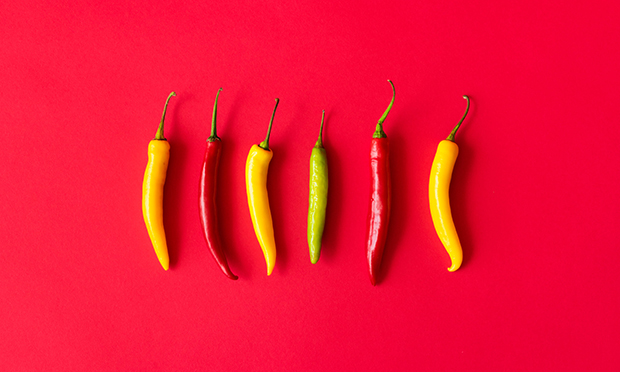Some like it hot

Pepper and peppers are really confusing in the way they share the same name but are in fact different plants.
The aromatic black peppercorns we grind over our food at table to give it a bit of a lift come from a vine-like plant, (piper nigrum of the piperaceae family) and have been enjoyed as a costly condiment for centuries. They are now cheap and plentiful, but in the past were a dear spice that only the elite could afford.
Capsicum peppers, chillies (capsicum annum of the solanaceae family), arrived much later, after the discovery of the New World at the end of the 15th century. Today we have a cheap and plentiful supply of them, mild bell or sweet peppers, and hot chilli peppers, with a comforting variety of spelling – the word comes from Nahuatl chilli, chile/chiles in Spanish, and chilli/chillies etc, according to usage.
There are so many different kinds, but the important thing about them is the flavour, not the heat. This is what chillies are all about.
The rather crude macho assessment of heat on the Scoville scale is misleading in the kitchen, where the burning shock of capsaicin (the substance that provides the heat) can ruin the subtle combination of flavours in a well-balanced dish, while just a little can stimulate the taste buds and cleverly add the chilli’s own flavour to the mix.
This capsaicin shock brings on a rush of endomorphins in the happy eater which makes her even happier, but is different in all of us, so that bottle of ketchup or hot sauce on the table, once despised by foodies, is now recognised as a potential enhancer of pleasure rather than a crude condiment.
Hackney is happily awash with different chilli sauces and ketchups, from the home-grown Dalston Chillies of Ben Kulchstein to a big range of hot sauces in most of our food stores.
There are hundreds of different chillies, each with its special aroma, that we can use in different recipes.
Mexican food uses a huge selection of fresh and dried chillies, but these are more difficult to find in our local food stores, for we don’t have the benefit of a flourishing Mexican population, and the joints that thrive on our intake of exotic cocktails usually have a disgusting travesty of Mexican food on offer. Avoid them.
Even the brilliant young chefs who are inspired by the cuisines of Peru and Mexico cannot create enough demand for the authentic chillies, or the importance of freshly made tortillas, but we are fortunate in having suppliers who can be reached online, like the Cool Chile Company in London, who have been selling fresh and dried Mexican chillies for over 20 years.
Our local Whole Foods store can set you up nicely with Cool Chile’s packs of mulato, ancho, pasilla, and other chillies, and both blue and blonde freshly made tortillas, and for those with the energy and a tortilla press, the masa harina for making them just before a meal, filling the kitchen with the aroma of soft corn masa as it puffs and blisters on your comal. Perfect therapy for an empty lockdown day, when the hours of toasting, soaking, grinding your chillies, roasting and crushing spices, simmering a chicken or turkey, bashing up some nuts with crisped tortillas, combining all these as directed by the awesome perfectionist Diana Kennedy (The Cuisines of Mexico, Harper and Row, 1972, pp. 199-203) will make the day much shorter and the meal much tastier.
But if your day is already too short, the Cool Chile Company again comes to the rescue with its pungent, carefully seasoned ketchups and adobos, and a tasty mole poblano, which can transform a tin of beans or a basic stew in minutes.
A pack of the many brands of ubiquitous tortilla chips (Whole Foods also makes its own) to scoop up some avocado mashed up in a pestle and mortar with fresh coriander, chillies and garlic, a little relish of chopped spring onions, tomatoes, fresh poblano chiles garlic and coriander, flung together in a few minutes, with some soured cream, makes a nice quick meal.
But Hackney has more than Mexico to entertain the taste buds, apart from the Turkish dried Aleppo chilli, available in flakes or powder or hot and mild pastes, and the fresh green tatli, sivri and urfa, while the Scotch Bonnet chilli, red, yellow or green, is everywhere, and a welcome addition to pungent Caribbean cooking.
This latter chilli can be very hot, but they vary in heat, as do all chillies. Cut a little bit off of one, sniff it, sometimes just a whiff will tell you, then lick it carefully, and assess how it might perform in whatever you are cooking.
The small, powerful bird’s eye chillies, and larger ones, from the mild chilli padron, to grill or fry and eat whole, and medium hot jalapeno, are just a few of those we can use locally.
We can grow our own with help from Sea Spring Seeds in Dorset, or buy traditional spice mixtures from Seasoned Pioneers in the Wirral or Steenberg’s in Yorkshire.
